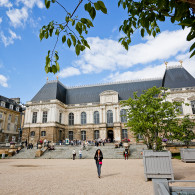Top French Cities - Toulouse at a glance
For more information, visit the Toulouse Tourist Office at www.toulouse-visit.com.
City region: Occitanie
Population & what they are called: 466,297 inhabitants (2014 census), called Toulousain
Access from Paris:
by road: about 6 h 30 min (420 miles) via the A20 autoroute l'Occitane
by train: about 4 h 10 min by TGV from the Gare Montparnasse
by plane: about 1 h 20 min to the Toulouse-Blagnac Airport
Famous native daughters & sons:
Abdelilah Chouari, breakdancer world champion
Claude Nougaro, singer
Bernard Werber, writer
Most distinctive and/or unique fact or trait (or little known fact):
Toulouse is nicknamed La Ville Rose (The Pink City) due to the red-brick façades seen all across town.
The 38 stations of Toulouse’s metro system are unique in that they all house works of contemporary art.
Notable sites:
Capitole – the 18th-century home of the Hôtel de Ville (City Hall), Théâtre du Capitole (opera house) and the Salle des Illustres (a display hall of 19th-century masterpieces by local artists)
Basilique Saint-Sernin – the largest remaining Romanesque building in Europe, containing the most beautiful pipe organ in the country
Couvent des Jacobins – a significant monastic building and the city's red brick jewel of Meridional Gothic architecture
Top annual events:
Festival Tangopostale – tango and Argentinian culture take over the city with performances, concerts, workshops and numerous cultural events (tangopostale.com)
Rio Loco – a lively open-air festival combining world music, visual arts, cinema and international cuisine (rio-loco.org/en)
Siestes Electroniques – free festival of electronic music in an open-air garden (les-siestes-electroniques.com)
Most notable museums:
Cité de l'Espace – a unique museum and park centered around space exploration (cite-espace.com)
Musée des Augustins (Musée des Beaux-Arts) – France's second oldest museum, with a large collection of European paintings (augustins.org)
Les Abattoirs (Musée d'Art Moderne et Contemporain) – a modern art museum built into the area's old slaughterhouse (lesabattoirs.org)
Culinary specialties:
saucisse de Toulouse – a special sausage composed of diced pork with no additives or preservatives
cassoulet toulousain – a slow-cooked stew of white haricot beans, duck confit and saucisse de Toulouse, served in a traditional earthenware pot
garbure – a hearty and thick peasant soup of cabbage, pork and a mix of other ingredients
Local wines & spirits:
wines of the Southwest – over 300 grape varieties, 14 named geographical areas and 29 protected appellations all regrouped as “vins du Sud-Ouest,” including the Candie estate within Toulouse and the nearby Fronton vineyard
crème de violette – a liqueur with taste and color of violet blossoms
Shopping:
Quartier de la Daurade – the best place for vintage and second-hand shops
Marché Victor Hugo – the biggest covered market, with restaurants on the first floor
Quartier Saint-Etienne – antique shops fill the little streets of neighborhood around the Saint-Étienne Cathedral
Most popular night spots:
Quartier des Carmes – one of the most active and dynamic neighborhood, with a vibrant range of popular bars and tapas restaurants
Place Saint-Pierre – a main nightlife area with many bars full of students
Rue Gabriel-Peri (near Jean-Jaurès Metro) – a good cluster of nightclubs, concert halls and bars
Local population’s favorite activities (or hangouts):
Canal du Midi – crowds of walkers, cyclists and rollerbladers take move along its banks every day
Garonne riverbank – a great place to observe the city skyline or step into a floating guinguette for a bite to eat in summer
Jardin des Plantes – a 200-year-old sculpture garden for people in search of nature
Local industries:
- aerospace industry – home to one of the world’s largest aeronautics manufacturers, Airbus, as well as the Galileo positioning system, the SPOT satellite system, the Aerospace Valley and more
In Pop Culture:
The Musketeer (D’Artagnan) – the 2001 film by Peter Hyams with Catherine Deneuve, shot in the Salle des Illustres of the Capitole
Lemming – the 2005 movie by Dominik Moll about love and betrayal
The Frozen Dead (Glacé), by Bernard Minier – a thriller novel, the first of the series involving Commandant Martin Servaz, a Toulouse city cop











